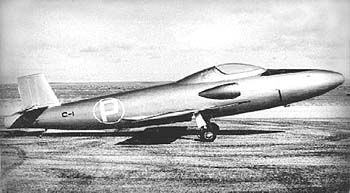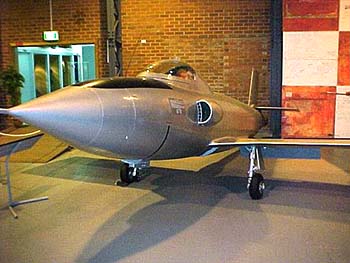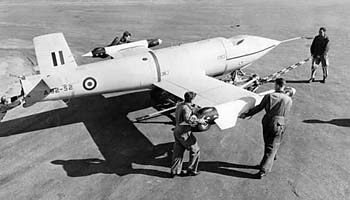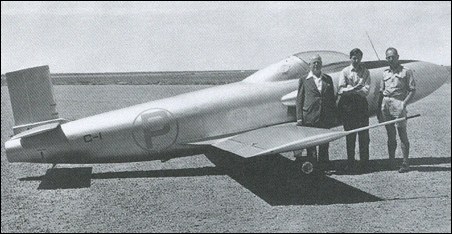F-35 NVG based HMD Selection
VSI’s Response the F-35 NVG based HMD Selection Published on Sunday, 11 September 2011
http://www.vsi-hmcs.com/index.php/blog/ ... -selection
“We at VSI understand the rationale behind the decision of the F-35 Joint Strike Fighter (JSF) Joint Program Office and Lockheed Martin to select a Night Vision Goggle (NVG) based HMD that integrates with legacy night vision goggles for the F-35 Lightning II. This will allow our company the room to mature our integrated night vision capability. VSI is confident that within a very short time, our F-35 GEN II HMDS will provide all the 5th generation HMD capabilities integral to the F-35. - Drew”
___________
Don't know more than the above at moment - here is some earlier background:
Lockheed Weighs Alternate F-35 Helmet Display Apr 21, 2011 By Graham Warwick
http://www.aviationweek.com/aw/generic/ ... %20Display
"Lockheed Martin plans to select the supplier of an alternate helmet-mounted display (HMD) for the F-35 Joint Strike Fighter by the end of this quarter.
Development issues with the primary Vision Systems International (VSI) visor-projected helmet-mounted display have led to the decision to pursue an alternate HMD to provide a night-vision capability. The F-35 does not have a head-up display (HUD), and an HMD capable of day and night operation is a critical requirement (Aerospace DAILY, March 4).
“To ensure we have a viable combat capability, we will have two paths for the HMD,” says Eric Branyan, F-35 deputy program manager, adding that the alternate helmet will use off-the-shelf Anvis-9 night vision goggles and provide both virtual-HUD and targeting information.
In parallel, work will continue on resolving display resolution issues with VSI’s Gen 2 HMD, which uses less-mature electron-bombarded active pixel sensor (Ebaps) technology. VSI says it is looking at more advanced versions of the Ebaps night-vision camera...."
http://www.vsi-hmcs.com/index.php/blog/ ... -selection
“We at VSI understand the rationale behind the decision of the F-35 Joint Strike Fighter (JSF) Joint Program Office and Lockheed Martin to select a Night Vision Goggle (NVG) based HMD that integrates with legacy night vision goggles for the F-35 Lightning II. This will allow our company the room to mature our integrated night vision capability. VSI is confident that within a very short time, our F-35 GEN II HMDS will provide all the 5th generation HMD capabilities integral to the F-35. - Drew”
___________
Don't know more than the above at moment - here is some earlier background:
Lockheed Weighs Alternate F-35 Helmet Display Apr 21, 2011 By Graham Warwick
http://www.aviationweek.com/aw/generic/ ... %20Display
"Lockheed Martin plans to select the supplier of an alternate helmet-mounted display (HMD) for the F-35 Joint Strike Fighter by the end of this quarter.
Development issues with the primary Vision Systems International (VSI) visor-projected helmet-mounted display have led to the decision to pursue an alternate HMD to provide a night-vision capability. The F-35 does not have a head-up display (HUD), and an HMD capable of day and night operation is a critical requirement (Aerospace DAILY, March 4).
“To ensure we have a viable combat capability, we will have two paths for the HMD,” says Eric Branyan, F-35 deputy program manager, adding that the alternate helmet will use off-the-shelf Anvis-9 night vision goggles and provide both virtual-HUD and targeting information.
In parallel, work will continue on resolving display resolution issues with VSI’s Gen 2 HMD, which uses less-mature electron-bombarded active pixel sensor (Ebaps) technology. VSI says it is looking at more advanced versions of the Ebaps night-vision camera...."
Last edited by spazsinbad on 11 Sep 2011, 13:50, edited 1 time in total.
Youse'll like this informative PDF. Diagram Sample to follow....
VR Displays, part 1 SGN-5406 Virtual Reality | Autumn 2009
http://www.cs.tut.fi/~ira/opetus/VR-displays1.pdf (1Mb)
_______________
Another PDF which may be interesting is:
Head-Mounted Display Systems Jannick Rolland & Hong Hua
"INTRODUCTION
Real-time three-dimensional (3D) interactive displays refer to display devices servo to the line of sight of a user, allowing not only free head motion, but also potentially and importantly full body mobility. Ideally, one could wish for such capability to exist without the need to wear any view-aided device. However, unless a display system could be created in space, anywhere and anytime, a simple solution is to wear the display. Such displays are today rather referred to as head-worn displays, but historically they have been referred to as head-mounted displays (HMDs). Because humans have not evolved to wear heavy devices, the challenge of interfacing such displays to the human head is tremendous, given that the challenge is to design HMDs with lightweight optics as well as lightweight and ergonomic optomechanical headsets. Because some of the display specifications play against each other in achieving a lightweight and ergonomic display, it is critical to drive such display design with targeted applications and associated tasks that will help prioritizing the display requirements.
This entry starts with a historical note and a perspective on contemporary pursuits in HMD designs. The main focus then shifts to details of the various components of HMDs, including the light source, various approaches to the optical design, and key aspects of the user interface. We then briefly review existing displays for both immersion and mixed reality. The final part discusses advanced pursuit in HMD designs."
FIRST GRAPHIC below is from this last PDF above
SECOND graphic below is from the first PDF mentioned
VR Displays, part 1 SGN-5406 Virtual Reality | Autumn 2009
http://www.cs.tut.fi/~ira/opetus/VR-displays1.pdf (1Mb)
_______________
Another PDF which may be interesting is:
Head-Mounted Display Systems Jannick Rolland & Hong Hua
"INTRODUCTION
Real-time three-dimensional (3D) interactive displays refer to display devices servo to the line of sight of a user, allowing not only free head motion, but also potentially and importantly full body mobility. Ideally, one could wish for such capability to exist without the need to wear any view-aided device. However, unless a display system could be created in space, anywhere and anytime, a simple solution is to wear the display. Such displays are today rather referred to as head-worn displays, but historically they have been referred to as head-mounted displays (HMDs). Because humans have not evolved to wear heavy devices, the challenge of interfacing such displays to the human head is tremendous, given that the challenge is to design HMDs with lightweight optics as well as lightweight and ergonomic optomechanical headsets. Because some of the display specifications play against each other in achieving a lightweight and ergonomic display, it is critical to drive such display design with targeted applications and associated tasks that will help prioritizing the display requirements.
This entry starts with a historical note and a perspective on contemporary pursuits in HMD designs. The main focus then shifts to details of the various components of HMDs, including the light source, various approaches to the optical design, and key aspects of the user interface. We then briefly review existing displays for both immersion and mixed reality. The final part discusses advanced pursuit in HMD designs."
FIRST GRAPHIC below is from this last PDF above
SECOND graphic below is from the first PDF mentioned
Last edited by spazsinbad on 12 Sep 2011, 01:14, edited 4 times in total.
Looks like this alternate (2004) did not make the cut.
BAE SYSTEMS Awarded Contract For Development Of Alternate F-35 Helmet-Mounted Display
08 Sep 2004
http://www.baesystems.com/Newsroom/News ... 92004.html
"BAE Systems Platform Solutions has been awarded a contract by Lockheed Martin for the initial design of an alternate helmet-mounted display (HMD) system for the F-35 Joint Strike Fighter aircraft. The helmet design is based heavily on the design of the Eurofighter Typhoon binocular helmet, which is in the final stages of development.
The F-35 JSF alternate HMD will be a high-resolution, binocular system driven by powerful processor and graphics processor modules. The head tracker, based on that in the Typhoon helmet, is a high speed, high-accuracy, low-latency optical system. The helmet will be designed to display “virtual HUD (Head-Up Display)” symbology and video imagery from the F-35 sensors and also will be compatible with helmet-mounted high-resolution night vision cameras...."
BAE SYSTEMS Awarded Contract For Development Of Alternate F-35 Helmet-Mounted Display
08 Sep 2004
http://www.baesystems.com/Newsroom/News ... 92004.html
"BAE Systems Platform Solutions has been awarded a contract by Lockheed Martin for the initial design of an alternate helmet-mounted display (HMD) system for the F-35 Joint Strike Fighter aircraft. The helmet design is based heavily on the design of the Eurofighter Typhoon binocular helmet, which is in the final stages of development.
The F-35 JSF alternate HMD will be a high-resolution, binocular system driven by powerful processor and graphics processor modules. The head tracker, based on that in the Typhoon helmet, is a high speed, high-accuracy, low-latency optical system. The helmet will be designed to display “virtual HUD (Head-Up Display)” symbology and video imagery from the F-35 sensors and also will be compatible with helmet-mounted high-resolution night vision cameras...."
- Forum Veteran

- Posts: 631
- Joined: 13 Jan 2010, 01:39
I think the idea of a fully immersive HMD for a fighter aircraft is one of the best things that can happen. UCAV's will be a while before they'll be suitable for full autonomy, and remote links can be jammed. With a pilot on board the aircraft with full spherical vision with sensor symbology, you could do all sorts of cool stuff....
eg:
Pilots could lay flat in aircraft and just view the world via the external cameras and sensor imagery. Would reduce RCS quite a bit and the pilot could handle a lot more G's for aggressive and high speed maneuvering. Imagine what a dogfighter could do with sustained, 17+ eyeballs-in G's and 46 G's instantenous?
eg:
Pilots could lay flat in aircraft and just view the world via the external cameras and sensor imagery. Would reduce RCS quite a bit and the pilot could handle a lot more G's for aggressive and high speed maneuvering. Imagine what a dogfighter could do with sustained, 17+ eyeballs-in G's and 46 G's instantenous?
Addition: Just to clarify about PIKA. Now that I've investigated (all that below here) and tried to remember, I'm thinking that the pilot flew in the first Jindivik prone as described or was a 'safety passenger/pilot' for the first few flights. THEN he was very glad to NOT have to fly in the Jindivik again AFAIK. Thus it became pilotless.
From dusty Flight Global archives comes the line drawing comparison side by side:
http://www.flightglobal.com/pdfarchive/ ... 01148.html
_____________
Many moons ago now the 'temporary' test pilot for the early Jindivik Target jet aircraft (PIKA) 'initially' was prone looking ahead in the 'aircraft' nose section. [Looks like arrangements may have been different subsequently from photos below.] He was glad not to do too many flights as 'spam in the can'. Subsequently the Jindivik went on to have a long successful career in Oz & UK as a radio controlled jet target (carried flares, cameras and other stuff for recording purposes).
http://www.ctie.monash.edu.au/hargrave/ ... divik.html
"...The Pika is the only manned jet aircraft to be designed and flown in Australia...." 1950
_______________
"By 1986, 500 Jindiviks had been built and production stopped in 1997. They remained in service in Britain until 2003 when the last Mk 4A was flown at Llanbedr in Wales." http://museumvictoria.com.au/collection ... t-aircraft
___________
More about PIKA here with two photos: http://www.airforce.gov.au/raafmuseum/e ... 0/pika.htm
_____________
PIKA on left - Jindivik must be on the other left:
http://www.ctie.monash.edu.au/hargrave/ ... 39_500.jpg

http://www.ctie.monash.edu.au/hargrave/ ... 51_350.jpg

http://www.ctie.monash.edu.au/hargrave/ ... ka_350.jpg

JINDIVIK with humans for scale:
http://www.ctie.monash.edu.au/hargrave/ ... ik_350.jpg

_____________
More Humans alongside PIKA: http://www.aviastar.org/air/australia/dap_pika.php
http://www.aviastar.org/pictures/australia/dap_pika.jpg

_________________
I recall (50 years ago?) seeing line drawings of the pilot flying prone and text saying that it was very uncomfortable and pilot complained. Looks like he sits upright - perhaps with legs flat out in front? - in this photo: http://img520.imageshack.us/img520/4108 ... allrx5.jpg

_______________
http://www.nntpnews.info/showthread.php ... agenumber=
"...The Pika could be controlled manually by the pilot or by the same
remote control system as the Jindivik. In an emergency, the pilot
could switch to manual control.
Two Pikas were built, the first (A93-1) taking to the air on 4
November 1950 in the hands of test pilot John Mills at Woomera in
South Australia. This plane was destroyed in an accident in April
1951.
The second (A93-2) taking over test duties in the same month, differed
in having an elongated nose and lengthened jet pipe.
After a successful test programme which contributed greatly to the
Jindivik’s success (both in terms of aerodynamics and systems), the
Pikas flying career ended in June 1954 with the completion of the
types 214th flight...."
From dusty Flight Global archives comes the line drawing comparison side by side:
http://www.flightglobal.com/pdfarchive/ ... 01148.html
_____________
Many moons ago now the 'temporary' test pilot for the early Jindivik Target jet aircraft (PIKA) 'initially' was prone looking ahead in the 'aircraft' nose section. [Looks like arrangements may have been different subsequently from photos below.] He was glad not to do too many flights as 'spam in the can'. Subsequently the Jindivik went on to have a long successful career in Oz & UK as a radio controlled jet target (carried flares, cameras and other stuff for recording purposes).
http://www.ctie.monash.edu.au/hargrave/ ... divik.html
"...The Pika is the only manned jet aircraft to be designed and flown in Australia...." 1950
_______________
"By 1986, 500 Jindiviks had been built and production stopped in 1997. They remained in service in Britain until 2003 when the last Mk 4A was flown at Llanbedr in Wales." http://museumvictoria.com.au/collection ... t-aircraft
___________
More about PIKA here with two photos: http://www.airforce.gov.au/raafmuseum/e ... 0/pika.htm
_____________
PIKA on left - Jindivik must be on the other left:
http://www.ctie.monash.edu.au/hargrave/ ... 39_500.jpg

http://www.ctie.monash.edu.au/hargrave/ ... 51_350.jpg

http://www.ctie.monash.edu.au/hargrave/ ... ka_350.jpg

JINDIVIK with humans for scale:
http://www.ctie.monash.edu.au/hargrave/ ... ik_350.jpg

_____________
More Humans alongside PIKA: http://www.aviastar.org/air/australia/dap_pika.php
http://www.aviastar.org/pictures/australia/dap_pika.jpg

_________________
I recall (50 years ago?) seeing line drawings of the pilot flying prone and text saying that it was very uncomfortable and pilot complained. Looks like he sits upright - perhaps with legs flat out in front? - in this photo: http://img520.imageshack.us/img520/4108 ... allrx5.jpg

_______________
http://www.nntpnews.info/showthread.php ... agenumber=
"...The Pika could be controlled manually by the pilot or by the same
remote control system as the Jindivik. In an emergency, the pilot
could switch to manual control.
Two Pikas were built, the first (A93-1) taking to the air on 4
November 1950 in the hands of test pilot John Mills at Woomera in
South Australia. This plane was destroyed in an accident in April
1951.
The second (A93-2) taking over test duties in the same month, differed
in having an elongated nose and lengthened jet pipe.
After a successful test programme which contributed greatly to the
Jindivik’s success (both in terms of aerodynamics and systems), the
Pikas flying career ended in June 1954 with the completion of the
types 214th flight...."
Last edited by spazsinbad on 11 Sep 2011, 16:48, edited 6 times in total.
- Elite 1K

- Posts: 1289
- Joined: 07 Oct 2007, 18:52
So the current Gen 1 HMD will lack the NV capability?
Got sidetracked by the PIKA  I'm not sure what the first press release - first entry in this thread is about except that the 'NVG' component is being used with the HMDS continuing development but not being used for moment? Anyway here is some info:
I'm not sure what the first press release - first entry in this thread is about except that the 'NVG' component is being used with the HMDS continuing development but not being used for moment? Anyway here is some info:
Fixes for Problem Plagued F-35 Helmet in the Works Shane McGlaun (Blog) - March 1, 2011
http://www.dailytech.com/Fixes+for+Prob ... e21023.htm
"...In the near term Vice Adm. David Venlet, JSF program chief, says that fixes might include moving some of the imagery from the helmet to the head-down flat panel displays and having the pilot use conventional night vision goggles.
However, Venlet says, "We're not giving up on the requirement."
The helmet developer Vision Systems International (VSI) says that it has a long-term solution to the issues mapped out. VSI president Drew Brugal said, "We have several engineering changes, which we have integrated in a block plan."
Brugal also noted that some of the modifications have already been integrated into the first two low-rate production helmets. One of the fixes for the video issues was to slip a shim 8/1000th of an inch between the helmet shell and the video component. Brugal says that one helmet in testing has shown significant improvements with the modifications installed. Part of the issue with image jitter was found to be the magnetic tracker reacting to the ejection seat vibrations.
VSI notes that it has written software that will overcome some of the jitter caused by the vibrations and in the future, it will install a small inertial measurement unit into the helmet to reduce the issue even more. The company hopes to eventually upgrade the helmet to color displays.
"Color is going to be incorporated into the future display. That's not part of our road map, but as we incorporate color into our other offerings, I would anticipate that color will part of the F-35 in the future," Brugal said...."
Fixes for Problem Plagued F-35 Helmet in the Works Shane McGlaun (Blog) - March 1, 2011
http://www.dailytech.com/Fixes+for+Prob ... e21023.htm
"...In the near term Vice Adm. David Venlet, JSF program chief, says that fixes might include moving some of the imagery from the helmet to the head-down flat panel displays and having the pilot use conventional night vision goggles.
However, Venlet says, "We're not giving up on the requirement."
The helmet developer Vision Systems International (VSI) says that it has a long-term solution to the issues mapped out. VSI president Drew Brugal said, "We have several engineering changes, which we have integrated in a block plan."
Brugal also noted that some of the modifications have already been integrated into the first two low-rate production helmets. One of the fixes for the video issues was to slip a shim 8/1000th of an inch between the helmet shell and the video component. Brugal says that one helmet in testing has shown significant improvements with the modifications installed. Part of the issue with image jitter was found to be the magnetic tracker reacting to the ejection seat vibrations.
VSI notes that it has written software that will overcome some of the jitter caused by the vibrations and in the future, it will install a small inertial measurement unit into the helmet to reduce the issue even more. The company hopes to eventually upgrade the helmet to color displays.
"Color is going to be incorporated into the future display. That's not part of our road map, but as we incorporate color into our other offerings, I would anticipate that color will part of the F-35 in the future," Brugal said...."
Last edited by spazsinbad on 13 Sep 2011, 15:17, edited 1 time in total.
STATEMENT OF LIEUTENANT GENERAL TERRY G. ROBLING, USMC DEPUTY COMMANDANT FOR AVIATION
AND
REAR ADMIRAL DAVID L. PHILMAN, USN DIRECTOR, WARFARE INTEGRATION
BEFORE THE AIRLAND SUBCOMMITTEE OF THE SENATE ARMED SERVICES COMMITTEE
ON DEPARTMENT OF THE NAVY’S TACTICAL AVIATION PROCUREMENT PROGRAM MAY 24, 2011
http://armed-services.senate.gov/statem ... -24-11.pdf
"...F-35 technical reviews have identified two critical technologies that were rated below the threshold for MS-B. One, the lift fan anti-icing system, has now been matured adequately to the necessary technical readiness level (TRL-6). The other, the Helmet Mounted Display System (HMDS), continues to experience technical difficulties. The program is implementing a dual-path strategy to reduce risk and inject competition into the HMDS development. The dual path has not alleviated the requirements of the ORD but will provide an interim warfighting capability while the ORD-compliant solution is matured...."
AND
REAR ADMIRAL DAVID L. PHILMAN, USN DIRECTOR, WARFARE INTEGRATION
BEFORE THE AIRLAND SUBCOMMITTEE OF THE SENATE ARMED SERVICES COMMITTEE
ON DEPARTMENT OF THE NAVY’S TACTICAL AVIATION PROCUREMENT PROGRAM MAY 24, 2011
http://armed-services.senate.gov/statem ... -24-11.pdf
"...F-35 technical reviews have identified two critical technologies that were rated below the threshold for MS-B. One, the lift fan anti-icing system, has now been matured adequately to the necessary technical readiness level (TRL-6). The other, the Helmet Mounted Display System (HMDS), continues to experience technical difficulties. The program is implementing a dual-path strategy to reduce risk and inject competition into the HMDS development. The dual path has not alleviated the requirements of the ORD but will provide an interim warfighting capability while the ORD-compliant solution is matured...."
- Forum Veteran

- Posts: 715
- Joined: 21 Nov 2009, 17:35
- Location: Columbia, Maryland, USA
spazsinbad wrote:Part of the issue with image jitter was found to be the magnetic tracker reacting to the ejection seat vibrations.
Sounds exactly like the kind of problem you'd experience moving a new technology from the lab to the real world.
There are active and adaptive optics technologies that could read the vibrations real-time and change the lens shape to cancel those distortions. Canon's image stabilization technology is similar but works purely with the digital image data. The camera monitors and cancels image blurring due to small movements.
spazsinbad wrote:Part of the issue with image jitter was found to be the magnetic tracker reacting to the ejection seat vibrations.
Reading that, I first thought, Why not put the tracker on a vibration dampening mount or some such thing? But having said that, I guess there could be a problem with tracker position drift when the jet has >1G on it.
Why does "monosyllabic" have 5 syllables?
More info on this thread (& others) about aspects of HMDS GenII:
http://www.f-16.net/f-16_forum_viewtopi ... rt-90.html
http://www.f-16.net/f-16_forum_viewtopi ... rt-90.html
- Banned
- Posts: 3123
- Joined: 11 Mar 2008, 15:28
They should have just contracted Sony on this sort of sh*t in the first place, imho. Commercial Head mounted displays will probably takeoff in spectacular fashion over the next 5 yrs. Sony will probably have an edge on this, or either buy the little guys who come up with something more ingenius. Share the dev costs, and say; "We'd really like to buy from you". That should have been enough of a green-light to get what was required.
The Super-Viper has not yet begun to concede.
12 posts
|Page 1 of 1
Who is online
Users browsing this forum: Bing [Bot] and 20 guests


